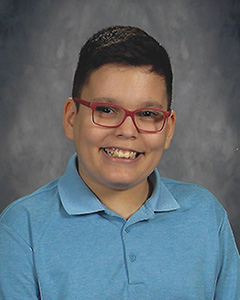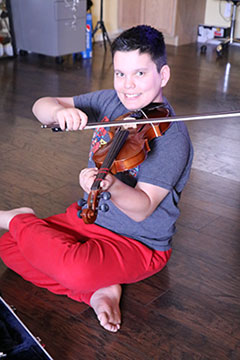DDD Member Aces a Life Test

Wearing a new shirt, Matteo smiles during the school photo session.
Tagen is the proud mother of 12-year-old twin boys, both of whom have autism. She encountered a dilemma with her son, Matteo, that caused a safety as well as a social concern. A stranger knocked at the front door of their home and Matteo let the woman in, without question. She stepped inside and asked if his mom was home. Without answering, Matteo sat back down in front of the TV and started playing video games. Fortunately, Matteo’s dad heard the unfamiliar voice from the other room, and came out to speak with the woman.
Tagen’s dilemma was two-fold: 1) How do you teach your child to speak up for himself when speech is a challenge for him? And 2) How do you explain “stranger danger” without your child becoming petrified of strangers, preventing them from seeking out help from an adult they don’t know? These are a few of the questions Tagen needed to have answered, so she turned to the DES Division of Developmental Disabilities (DDD) for guidance.
“I talked with his speech [therapist] at the time and I told her what had happened,” said Tagen. She asked the therapist to incorporate safety responses in her sessions with Matteo as well. Tagen then reinforced her son’s speech sessions with life lessons. Almost like a game, when Tagen and Matteo were out at restaurants or shopping, “We would talk about who were workers and who were shoppers,” said Tagen. “When we looked for workers, we were trying to understand that a lot of workers look the same. They either have an apron on or a shirt that makes them stand out. We worked on it.”

Matteo is learning to play the violin at Falcon Elementary School where science is his favorite subject.
That work paid off last fall.
School picture time was coming up. When he got home from school, Tagen took Matteo to buy a new shirt. After passing the toy section on the way to the fitting rooms, Matteo asked if he could look at the toys, which Tagen allowed. She then walked to and from the shirt section, and on her way back, she walked through the toy section to look for Matteo, but he was nowhere to be found. After calling out his name, she was approached by a store employee who asked if she was Tagen. The employee then brought Matteo over to her.
Matteo explained, “I got lost when I was checking on toys. A woman … a worker … helped me find my mom.” Matteo said to the sales associate, “I’m lost. Can you help me find my mommy?”
The sales employee looked at Tagen and said, “He did so good.”
“It was amazing to hear! He just did everything right! All of our hard work had paid off. I was very glad that the situation did occur because, you just don’t know – because that’s [a situation that’s] hard to simulate. Luckily, it was a good outcome to a scary experience.”
What may seem like a small success amounts to a monumental victory for Matteo and his safety. His speech therapist’s ability to respond to his individual needs as communicated by Tagen is emblematic of the ways in which services and supports by DDD providers can transform how DDD members engage with the world.
To learn more about DDD services, please visit the DDD website.

